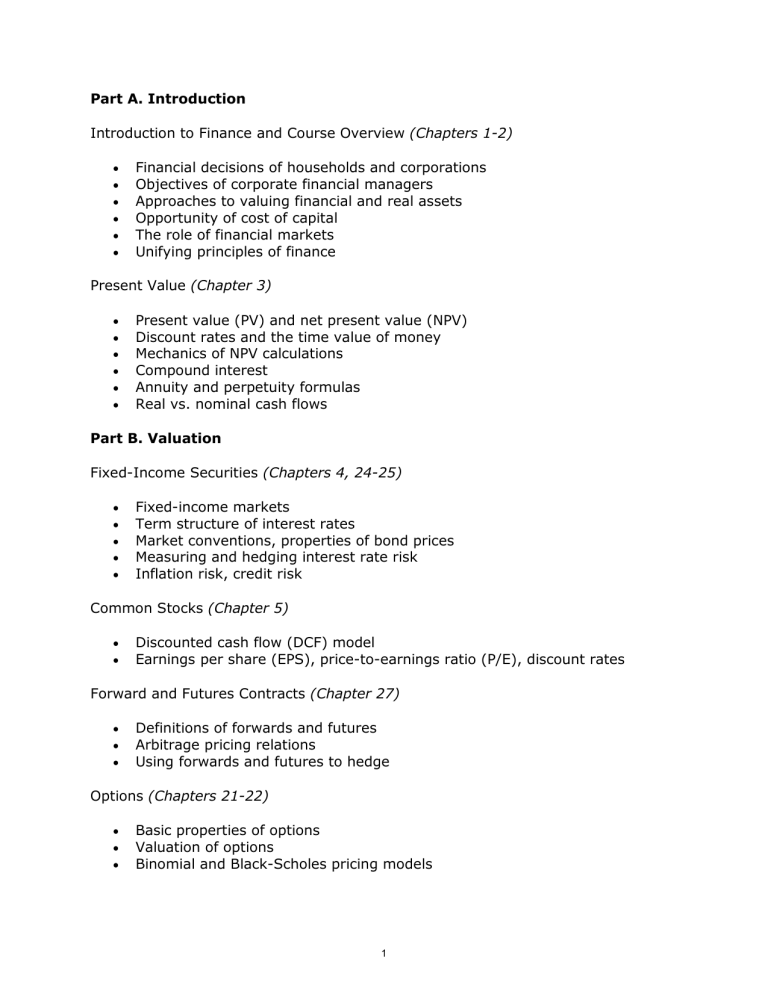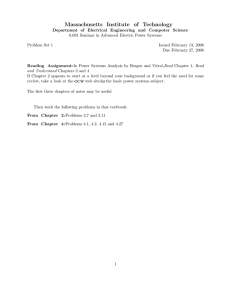Part A. Introduction (Chapters 1-2) Financial decisions of households and corporations

Part A. Introduction
Introduction to Finance and Course Overview (Chapters 1-2)
• Financial decisions of households and corporations
•
•
Objectives of corporate financial managers
Approaches to valuing financial and real assets
•
•
•
Opportunity of cost of capital
The role of financial markets
Unifying principles of finance
Present Value (Chapter 3)
•
•
•
•
•
•
Present value (PV) and net present value (NPV)
Discount rates and the time value of money
Mechanics of NPV calculations
Compound interest
Annuity and perpetuity formulas
Real vs. nominal cash flows
Part B. Valuation
Fixed-Income Securities (Chapters 4, 24-25)
• Fixed-income markets
• Term structure of interest rates
• Market conventions, properties of bond prices
• Measuring and hedging interest rate risk
• Inflation risk, credit risk
Common Stocks (Chapter 5)
•
•
Discounted cash flow (DCF) model
Earnings per share (EPS), price-to-earnings ratio (P/E), discount rates
Forward and Futures Contracts (Chapter 27)
•
•
•
Definitions of forwards and futures
Arbitrage pricing relations
Using forwards and futures to hedge
Options (Chapters 21-22)
•
•
•
Basic properties of options
Valuation of options
Binomial and Black-Scholes pricing models
1
Part C. Risk and Return
Introduction to Risk and Return (Chapters 7, 24.1, 24.4)
• Historical asset returns
• Risk/reward trade-off
Risk Analytics (Chapter 8)
•
•
Measures of risk
Risk and investment horizon
Portfolio Theory (Chapters 8, 9.1)
•
•
•
Diversification, systematic and idiosyncratic risk
Portfolio optimization
Efficient risk/return trade-offs
The Capital Asset Pricing Model (CAPM) (Chapters 9.2-9.3)
•
•
•
The CAPM and linear risk/return trade-offs
Applications of the CAPM
Empirical evidence and extensions of the CAPM
Part D. Corporate Finance
Capital Budgeting I (Chapters 6-7, 10, 23)
• Capital budgeting criteria
• NPV rule, cash flow calculations, discount rates
Capital Budgeting II
• Project interactions
• Real options
Capital Budgeting III
• Case discussion: Acid Rain
Market Efficiency (Chapter 14)
•
•
•
Origins of the efficient markets hypothesis (EMH)
Implications and empirical tests of the EMH
Recent developments
2
MIT OpenCourseWare http://ocw.mit.edu
15.401
Finance Theory I
Fall 20 08
For information about citing these materials or our Terms of Use, visit: http://ocw.mit.edu/terms .




